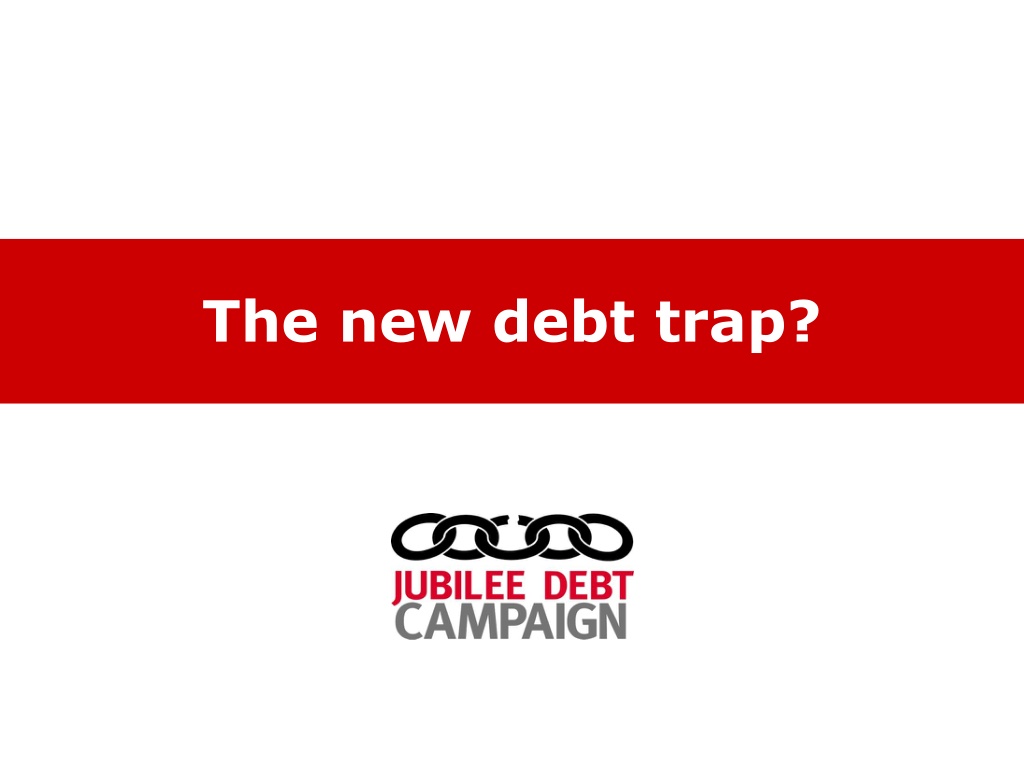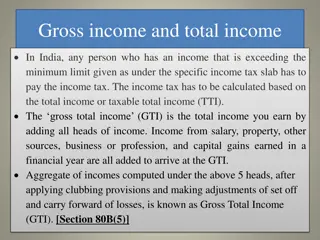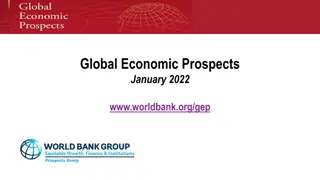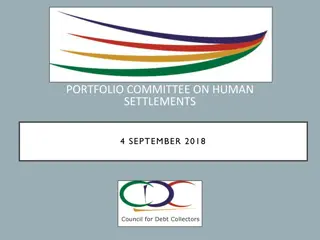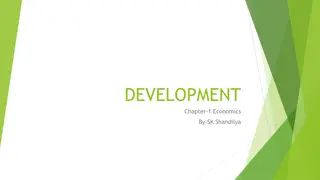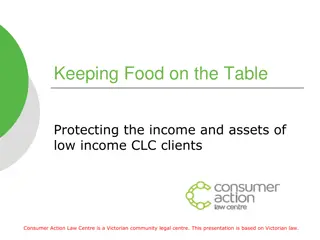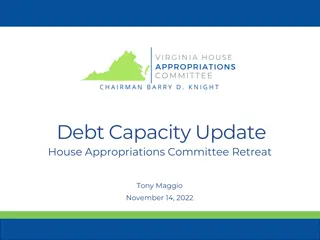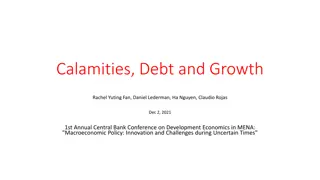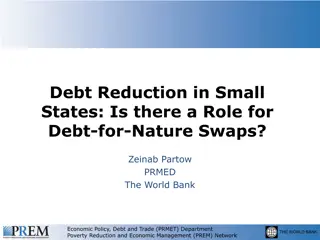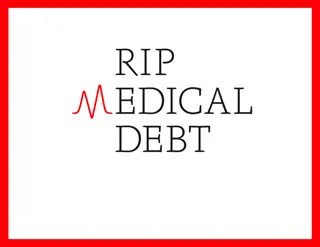Understanding the New Debt Dynamics in Low-Income Countries
Analysis of external debt levels, debt payments, and lending trends in low-income countries between 2000 and 2015 reveals challenges and risks. Nine countries are identified as being highly exposed to foreign lending, with implications for economic growth, poverty reduction, inequality, and commodity dependence. The data highlights the need for sustainable debt management strategies and policies to address the complexities of debt dynamics in these nations.
Download Presentation

Please find below an Image/Link to download the presentation.
The content on the website is provided AS IS for your information and personal use only. It may not be sold, licensed, or shared on other websites without obtaining consent from the author. Download presentation by click this link. If you encounter any issues during the download, it is possible that the publisher has removed the file from their server.
E N D
Presentation Transcript
External debt levels stable? External debt as proportion of GDP, low income and recently graduated, 2000 - 2014 (Source: World Bank) 80 70 60 50 % of GDP 40 30 20 10 0 2000 2001 2002 2003 2004 2005 2006 2007 2008 2009 2010 2011 2012 2013 2014
Slight increase in debt payments Debt service as proportion of exports, low income and recently graduated, 2000 - 2015 (Source: World Bank) 12 10 8 % of exports 6 4 2 0 2000 2001 2002 2003 2004 2005 2006 2007 2008 2009 2010 2011 2012 2013 2014
Significant increase in lending in recent years External loan disbursements to low income and recently graduated, $ billion, 2005 - 2014 (Source: World Bank) 50 45 40 35 30 $ billion 25 20 15 10 5 0 2005 2006 2007 2008 2009 2010 2011 2012 2013 2014 Other governments Multilateral institutions Bonds Other private lenders
Projections made in 2013/2014 for increasing debt payments
Nine countries most exposed to foreign lending Significant net external debt (over 30% of GDP) Significant projected future government external debt payments (over 15% of revenue) Significant and sustained current account deficits (over 5% of GDP) Bhutan, Ethiopia, Ghana, Lao, Mongolia, Mozambique, Senegal, Tanzania, Uganda
Analysis of nine countries 1) Growing faster (average annual growth rate 4.74% 2008-2013, compared to 3.64%) 2) Not reducing poverty faster. In five of the nine, people living in poverty increasing. Only Bhutan, Ghana and Mongolia reducing poverty at a faster rate than the average 3) Inequality increasing in eight of nine (Mozambique exception, but already most unequal) 4) Commodity export dependence has not fallen
Commodity dependence has not fallen
Since 2014: Commodity price fall IMF Commodity Price Index 250.00 200.00 150.00 100.00 50.00 0.00 2005M1 2005M4 2005M7 2005M10 2006M1 2006M4 2006M7 2006M10 2007M1 2007M4 2007M7 2007M10 2008M1 2008M4 2008M7 2008M10 2009M1 2009M4 2009M7 2009M10 2010M1 2010M4 2010M7 2010M10 2011M1 2011M4 2011M7 2011M10 2012M1 2012M4 2012M7 2012M10 2013M1 2013M4 2013M7 2013M10 2014M1 2014M4 2014M7 2014M10 2015M1 2015M4 2015M7 2015M10 2016M1 2016M4
Since 2014: dollar increase in value
Currency depreciations since start 2015 Ghanaian Cedi: Down 39% against the dollar Mozambique Metical: Down 49% against the dollar Tanzanian Schilling: Down 28% against the dollar Zambian Kwacha: Down 46% against the dollar
Interest cost of the debt Interest rates: Eurobonds and other private external: 7.9% - 10.75% Cedi debt: 7% (average real interest rate) Other governments: 4.5% estimated Multilateral institutions: 0% - 2%
Projected Ghana government external debt payments Ghana government external debt service as proportion of revenue, 1995-2035 (Source: IMF) 45 40 35 30 % of revenue 25 20 15 10 5 0 1995 1996 1997 1998 1999 2000 2001 2002 2003 2004 2005 2006 2007 2008 2009 2010 2011 2012 2013 2014 2015 2016 2017 2018 2019 2020 2021 2022 2023 2024 2025 2026 2027 2028 2029 2030 2031 2032 2033 2034 2035
Assumptions for sustainability IMF view that external debt is sustainable based on assumptions: $GDP growth averaging 8.2% a year until 2035 Government $ revenue grows in line with GDP A fall in average interest rate on external debt from 5.1% to 4.1% Continual primary budget surpluses
Real government spending projected to fall
External bond refinancing could be difficult Most recent Eurobond autumn 2015: $1bn borrowed at 10.75% But World Bank guaranteed $400m This implies cost would have been 16.25% without guarantee As long as government keeps paying interest until 2025, lenders will have made a profit
Mozambique and the hidden debt
Mozambique and the hidden debt 1. $726.5 million Eurobond: issued through Credit Suisse and VTB Bank in 2013. English law, London branches. It was not approved by the Mozambique parliament. 2. $597 million direct loan: 81% of the loan was from Credit Suisse, 19% VTB. English law, London branches. It was not approved by the Mozambique parliament. 3. $535 million direct loan from VTB. English law, London branches. It is now thought to be in default. It was not approved by the Mozambique parliament.
Mozambique and the hidden debt Mozambique's debt? Domestic 15% World Bank 23% Other private external 4% VTB 6% Other multilateral 9% Credit Suisse 4% Hidden bilateral 2% IMF 2% Eurobond 6% China 12% Other non-Paris Club 8% Paris Club 9%
New debt crisis? 1. Are Ghana and Mozambique the start of a new crisis or individual cases? Other recently agreed IMF bail outs: Sri Lanka, Tunisia. Zambia to come? 2. Wide range of creditors in both cases. 3. Dominance of English law for impoverished countries private external debts. 95% of sub-Saharan Africa (excluding South Africa) bonds owed under English law.
